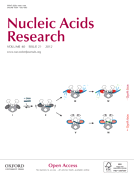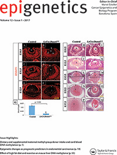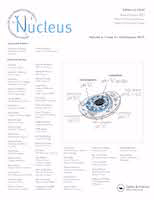
NUCLEIC ACIDS RESEARCH
Scope & Guideline
Illuminating the Pathways of Nucleic Acids
Introduction
Aims and Scopes
- Nucleic Acid Structure and Function:
Research focusing on the structural and functional aspects of DNA and RNA, including studies on G-quadruplexes, ribozymes, and RNA modifications. - Gene Regulation and Expression:
Explorations of the mechanisms that control gene expression, including transcription factors, enhancers, silencers, and the role of non-coding RNAs. - DNA Repair and Replication:
Investigations into the molecular mechanisms of DNA repair pathways, replication processes, and the impact of various factors on genomic integrity. - CRISPR and Genome Editing Technologies:
Studies on the development and application of CRISPR and other genome editing technologies, including their mechanisms, efficiency, and specificity. - Epigenetics and Chromatin Dynamics:
Research addressing the role of epigenetic modifications and chromatin structure in regulating gene expression and maintaining genomic stability. - Bioinformatics and Computational Biology:
Development and application of computational tools and databases for analyzing nucleic acid sequences, structures, and interactions.
Trending and Emerging
- RNA Modifications and Function:
Research focusing on various RNA modifications, such as m6A and pseudouridylation, is gaining momentum, emphasizing their roles in gene regulation, stability, and cellular responses. - CRISPR Technologies and Applications:
There is a rapidly growing body of work exploring novel CRISPR applications, including base editing, epigenome editing, and their therapeutic potential in various diseases. - Synthetic Biology and RNA Engineering:
Emerging studies on engineered RNA molecules and synthetic biology approaches are trending, particularly in the context of developing novel therapeutics and gene regulation systems. - Phase Separation and Biomolecular Condensates:
Research on the role of phase separation in cellular organization and function is increasingly prominent, particularly in relation to RNA-binding proteins and their interactions. - Metagenomics and Microbiome Studies:
The integration of nucleic acid research with metagenomics and microbiome analysis is on the rise, showcasing the importance of microbial communities in health and disease. - Machine Learning in Genomics:
The application of machine learning techniques to analyze genomic data and predict functional outcomes is an emerging trend, facilitating more efficient data interpretation and discovery.
Declining or Waning
- Traditional Molecular Biology Techniques:
There has been a notable decrease in publications centered around classical molecular biology techniques, such as basic cloning and PCR methods, which have been largely supplanted by more advanced and sophisticated technologies. - Single-Gene Studies:
Research focusing on the characterization of single genes has diminished, as the field increasingly moves towards understanding complex interactions and networks involving multiple genes and regulatory elements. - Static Structural Studies:
Static studies that provide a snapshot of molecular structures without dynamic considerations are becoming less prominent, as researchers prioritize studies that incorporate dynamic and functional aspects of nucleic acids. - Basic RNA Isolation Techniques:
The frequency of articles dedicated solely to basic RNA isolation and purification techniques has decreased, as researchers now often integrate these methods within broader studies of RNA function and dynamics.
Similar Journals

Epigenetics & Chromatin
Illuminating the Complexities of ChromatinEpigenetics & Chromatin, published by BMC, is a leading open-access journal that has been at the forefront of research in the fields of genetics and molecular biology since its inception in 2008. With an impressive Q1 category ranking in both Genetics and Molecular Biology as of 2023, this journal is pivotal for researchers and professionals aiming to explore the complexities of gene regulation and chromatin dynamics. The journal is renowned for its commitment to disseminating high-quality research, featuring diverse articles ranging from original research to comprehensive reviews. It enjoys a significant impact within the academic community, evidenced by its Scopus rankings that place it among the top 30% of journals in Genetics and the top 40% in Molecular Biology. With a dedicated open-access model, Epigenetics & Chromatin ensures that its comprehensive content is readily accessible to researchers globally, fostering collaboration and innovation across the scientific landscape. Located in the UK, the journal continues to attract a diverse audience of scholars and practitioners passionate about understanding the intricate layers of epigenetic regulation.

TRENDS IN GENETICS
Advancing the Frontiers of Genetic ResearchTRENDS IN GENETICS, published by CELL PRESS, is a leading journal in the field of genetics, recognized for its significant impact on research and advancements in the discipline. With an impressive Scopus ranking of #10 out of 347 in the category of Genetics and a 97th percentile ranking, this journal stands as a premier platform for publishing innovative, high-quality articles that shape the future of genetic research. Since its inception in 1985, TRENDS IN GENETICS has been at the forefront of the genetic sciences, continuously disseminating crucial findings while maintaining a strong commitment to scientific rigor and integrity. Although it does not currently offer open access options, its rigorous peer-review process ensures that only the most relevant and groundbreaking studies make it to publication. Scholars and practitioners in genetics will find this journal to be an invaluable resource for keeping abreast of the latest developments, trends, and methodologies that drive the field forward.

Epigenetics
Illuminating the Pathway to Epigenetic BreakthroughsEpigenetics, published by Taylor & Francis Inc, is a leading journal in the fields of Cancer Research, Medicine (miscellaneous), and Molecular Biology. With an ISSN of 1559-2294 and an E-ISSN of 1559-2308, this journal has been paving the way for groundbreaking research since its inception in 2006, and it continues to play a crucial role in advancing our understanding of epigenetic mechanisms and their implications in health and disease. The journal is highly regarded, ranking in the Q1 category for Medicine and Q2 for both Cancer Research and Molecular Biology according to the 2023 category quartiles. Researchers and professionals in the field will find invaluable insights and innovative studies within its pages, making it an essential resource for those engaged in cutting-edge research. Although the journal is not open access, it encourages a comprehensive understanding through high-quality peer-reviewed content. With its creative exploration of the epigenetic landscape, Epigenetics serves as a vital platform for the sharing of knowledge that could lead to breakthroughs in treatments and therapies.

RNA
Exploring the Essence of Life Through RNARNA is a premier journal in the field of molecular biology, published by COLD SPRING HARBOR LAB PRESS, PUBLICATIONS DEPT. With an impressive impact factor reflected by its Q1 status in the Molecular Biology category, this journal has established itself as an essential resource for researchers and professionals dedicated to understanding the role of RNA in biological processes. Spanning over two decades of impactful research from 1995 to 2024, RNA covers a broad spectrum of topics, including RNA biology, gene regulation, and therapeutic innovations. Researchers can access its extensive array of original research articles, reviews, and commentary, making it a vital conduit for new discoveries and methodologies in the field. With its high ranking within Scopus at Rank #115/410 and a 72nd percentile ranking in the domain of Biochemistry, Genetics, and Molecular Biology, RNA continues to advance the understanding of RNA and its critical contributions to life sciences.

Nucleus
Catalyzing breakthroughs in cell biology and medicine.Nucleus is a distinguished academic journal published by Taylor & Francis Inc, dedicated to advancing the fields of Cell Biology and Medicine. Since its inception, the journal has gained significant recognition, achieving a Q1 ranking in both Cell Biology and Medicine (miscellaneous) categories in 2023. With a focus on innovative research that intersects molecular biology and genetics, Nucleus serves as a vital platform for researchers and professionals aiming to disseminate findings that contribute to our understanding of cellular mechanisms and their implications in health and disease. The journal's commitment to Open Access since 2018 ensures that cutting-edge research is readily available to the global community, fostering collaboration and engagement across disciplines. Located in Philadelphia, PA, Nucleus not only aims to publish high-quality articles but also aspires to influence future research directions in the biological sciences, making it an essential resource for anyone involved in the life sciences.

DNA REPAIR
Advancing Knowledge in Molecular Repair MechanismsDNA Repair, published by Elsevier, is a leading journal in the fields of biochemistry, cell biology, and molecular biology, presenting cutting-edge research since its inception in 2002. With an impressive Q1 ranking across its categories in 2023, the journal stands out in the top quartile of its field, reflecting its significant impact and relevance in the scientific community. The journal focuses on the intricate mechanisms of DNA repair processes, essential for understanding cellular responses to DNA damage and the implications for diseases such as cancer. Researchers, professionals, and students will find DNA Repair an invaluable resource, offering open-access options for wider dissemination of knowledge, while its strong Scopus rankings underline its contribution to advancing the understanding of molecular interactions and biochemistry. Located in the heart of the Netherlands, the journal continues to be at the forefront of scientific discovery, promoting the exploration of DNA dynamics and the innovations arising from this critical area of study.

MOLECULAR BIOLOGY OF THE CELL
Innovating Insights into Cellular MechanismsMOLECULAR BIOLOGY OF THE CELL is a prestigious journal published by the American Society for Cell Biology, focusing on the latest advancements in cell biology and molecular biology. Established in 1990, this journal serves as a vital forum for disseminating innovative research, methodologies, and insights that drive the understanding of cellular processes and their implications in health and disease. With a noteworthy impact factor and recognition within the top quartiles for both Cell Biology and Molecular Biology, it ranks prominently among its peers, with Scopus rankings reflecting its significance in the scientific community. Although the journal does not follow an open access model, it provides essential access options for both institutional and personal subscriptions. Researchers, professionals, and students seeking to expand their knowledge and collaborate on groundbreaking findings will find MOLECULAR BIOLOGY OF THE CELL an invaluable resource in the field.

DNA AND CELL BIOLOGY
Connecting Researchers to the Heart of BiologyDNA AND CELL BIOLOGY, published by Mary Ann Liebert, Inc, is a distinguished journal in the realms of cell biology, genetics, and molecular biology, holding a notable position in its Q3 and Q2 quartile rankings across multiple academic categories as of 2023. With an ISSN of 1044-5498 and an E-ISSN of 1557-7430, this journal has been a pivotal platform for the dissemination of cutting-edge research since its inception in 1990, extending its coverage through 2024. Situated in the United States, the journal offers high-quality peer-reviewed articles, exploring significant advancements in biological sciences while fostering interdisciplinary collaborations within the research community. Though it currently does not offer open access, subscribed institutions and individual readers benefit from its rich repository of knowledge. The journal's rigorous standards and impactful content make it an essential resource for researchers, professionals, and students alike, aiming to stay at the forefront of discoveries influencing DNA and cellular dynamics.

Non-Coding RNA
Innovating the Future of Genomic ResearchNon-Coding RNA is a prestigious open-access journal published by MDPI, based in Switzerland, dedicated to the significant and rapidly evolving field of non-coding RNA research. Established in 2015, this journal has quickly become an essential resource for researchers and professionals, showcasing innovative studies and breakthroughs related to the functions and mechanisms of non-coding RNAs in various biological processes. With an impressive Q1 ranking in Biochemistry and strong rankings in Genetics and Molecular Biology, Non-Coding RNA consistently reflects the highest standards of academic publishing. The journal provides comprehensive access options, granting researchers worldwide the ability to disseminate and access high-quality research without subscription barriers. As the landscape of genomics and molecular discoveries continues to expand, the journal aims to foster interdisciplinary exchanges and collaborations, making it a vital platform for advancing knowledge and innovation in this critical area of biological science.

Biochemistry and Cell Biology
Shaping the future of biochemistry and cell biology through shared insights.Biochemistry and Cell Biology, published by Canadian Science Publishing, is a prestigious journal that has been instrumental in advancing the fields of biochemistry, molecular biology, and cell biology since its inception in 1986. With an impressive scope spanning innovative research findings to comprehensive reviews, this journal serves as a vital resource for researchers, professionals, and students alike. Currently positioned in the Q2 quartile in Biochemistry and Q3 quartiles in both Cell Biology and Molecular Biology, it reflects a robust contribution to scientific discourse, placing it among reputable publications in its field. The journal boasts notable rankings within the Scopus database, highlighting its impact and relevance, and continues to be a valuable platform for disseminating pivotal research. By providing access to a wide array of articles, the journal remains committed to fostering knowledge and collaboration in the scientific community.